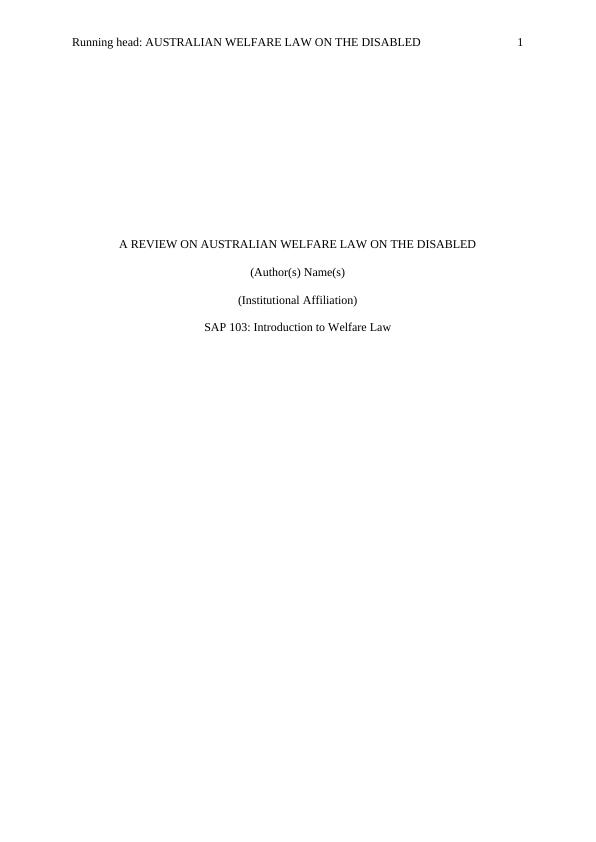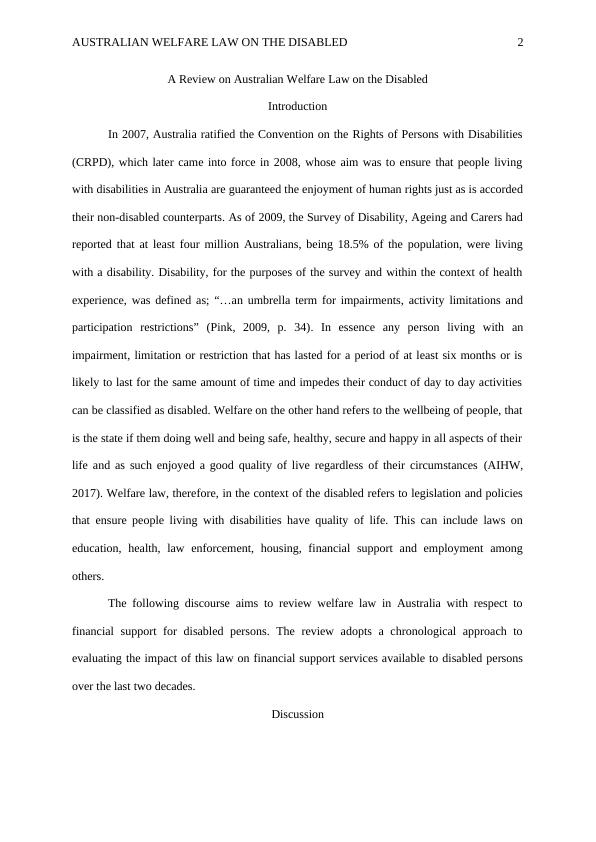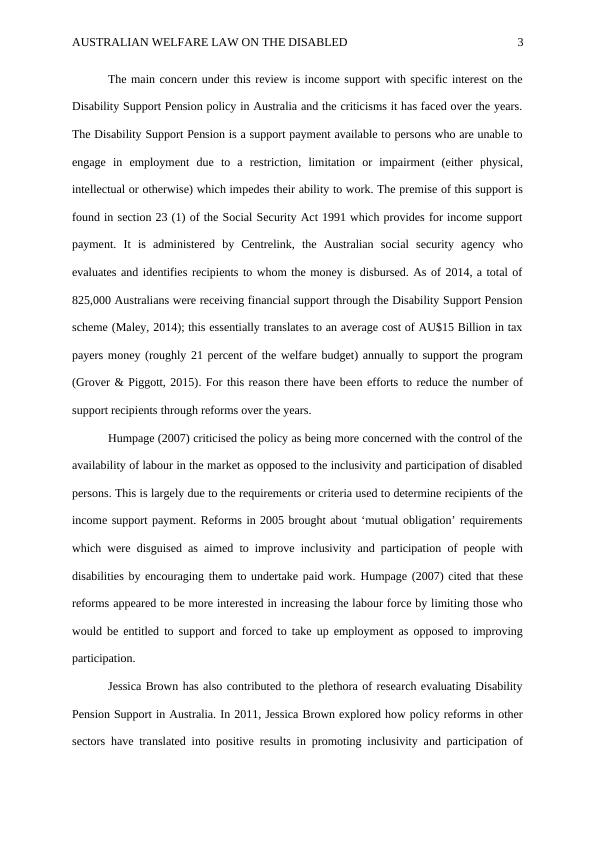Australian Welfare Law on the Disabled
Added on 2022-11-13
7 Pages1739 Words62 Views
Running head: AUSTRALIAN WELFARE LAW ON THE DISABLED 1
A REVIEW ON AUSTRALIAN WELFARE LAW ON THE DISABLED
(Author(s) Name(s)
(Institutional Affiliation)
SAP 103: Introduction to Welfare Law
A REVIEW ON AUSTRALIAN WELFARE LAW ON THE DISABLED
(Author(s) Name(s)
(Institutional Affiliation)
SAP 103: Introduction to Welfare Law

AUSTRALIAN WELFARE LAW ON THE DISABLED 2
A Review on Australian Welfare Law on the Disabled
Introduction
In 2007, Australia ratified the Convention on the Rights of Persons with Disabilities
(CRPD), which later came into force in 2008, whose aim was to ensure that people living
with disabilities in Australia are guaranteed the enjoyment of human rights just as is accorded
their non-disabled counterparts. As of 2009, the Survey of Disability, Ageing and Carers had
reported that at least four million Australians, being 18.5% of the population, were living
with a disability. Disability, for the purposes of the survey and within the context of health
experience, was defined as; “...an umbrella term for impairments, activity limitations and
participation restrictions” (Pink, 2009, p. 34). In essence any person living with an
impairment, limitation or restriction that has lasted for a period of at least six months or is
likely to last for the same amount of time and impedes their conduct of day to day activities
can be classified as disabled. Welfare on the other hand refers to the wellbeing of people, that
is the state if them doing well and being safe, healthy, secure and happy in all aspects of their
life and as such enjoyed a good quality of live regardless of their circumstances (AIHW,
2017). Welfare law, therefore, in the context of the disabled refers to legislation and policies
that ensure people living with disabilities have quality of life. This can include laws on
education, health, law enforcement, housing, financial support and employment among
others.
The following discourse aims to review welfare law in Australia with respect to
financial support for disabled persons. The review adopts a chronological approach to
evaluating the impact of this law on financial support services available to disabled persons
over the last two decades.
Discussion
A Review on Australian Welfare Law on the Disabled
Introduction
In 2007, Australia ratified the Convention on the Rights of Persons with Disabilities
(CRPD), which later came into force in 2008, whose aim was to ensure that people living
with disabilities in Australia are guaranteed the enjoyment of human rights just as is accorded
their non-disabled counterparts. As of 2009, the Survey of Disability, Ageing and Carers had
reported that at least four million Australians, being 18.5% of the population, were living
with a disability. Disability, for the purposes of the survey and within the context of health
experience, was defined as; “...an umbrella term for impairments, activity limitations and
participation restrictions” (Pink, 2009, p. 34). In essence any person living with an
impairment, limitation or restriction that has lasted for a period of at least six months or is
likely to last for the same amount of time and impedes their conduct of day to day activities
can be classified as disabled. Welfare on the other hand refers to the wellbeing of people, that
is the state if them doing well and being safe, healthy, secure and happy in all aspects of their
life and as such enjoyed a good quality of live regardless of their circumstances (AIHW,
2017). Welfare law, therefore, in the context of the disabled refers to legislation and policies
that ensure people living with disabilities have quality of life. This can include laws on
education, health, law enforcement, housing, financial support and employment among
others.
The following discourse aims to review welfare law in Australia with respect to
financial support for disabled persons. The review adopts a chronological approach to
evaluating the impact of this law on financial support services available to disabled persons
over the last two decades.
Discussion

AUSTRALIAN WELFARE LAW ON THE DISABLED 3
The main concern under this review is income support with specific interest on the
Disability Support Pension policy in Australia and the criticisms it has faced over the years.
The Disability Support Pension is a support payment available to persons who are unable to
engage in employment due to a restriction, limitation or impairment (either physical,
intellectual or otherwise) which impedes their ability to work. The premise of this support is
found in section 23 (1) of the Social Security Act 1991 which provides for income support
payment. It is administered by Centrelink, the Australian social security agency who
evaluates and identifies recipients to whom the money is disbursed. As of 2014, a total of
825,000 Australians were receiving financial support through the Disability Support Pension
scheme (Maley, 2014); this essentially translates to an average cost of AU$15 Billion in tax
payers money (roughly 21 percent of the welfare budget) annually to support the program
(Grover & Piggott, 2015). For this reason there have been efforts to reduce the number of
support recipients through reforms over the years.
Humpage (2007) criticised the policy as being more concerned with the control of the
availability of labour in the market as opposed to the inclusivity and participation of disabled
persons. This is largely due to the requirements or criteria used to determine recipients of the
income support payment. Reforms in 2005 brought about ‘mutual obligation’ requirements
which were disguised as aimed to improve inclusivity and participation of people with
disabilities by encouraging them to undertake paid work. Humpage (2007) cited that these
reforms appeared to be more interested in increasing the labour force by limiting those who
would be entitled to support and forced to take up employment as opposed to improving
participation.
Jessica Brown has also contributed to the plethora of research evaluating Disability
Pension Support in Australia. In 2011, Jessica Brown explored how policy reforms in other
sectors have translated into positive results in promoting inclusivity and participation of
The main concern under this review is income support with specific interest on the
Disability Support Pension policy in Australia and the criticisms it has faced over the years.
The Disability Support Pension is a support payment available to persons who are unable to
engage in employment due to a restriction, limitation or impairment (either physical,
intellectual or otherwise) which impedes their ability to work. The premise of this support is
found in section 23 (1) of the Social Security Act 1991 which provides for income support
payment. It is administered by Centrelink, the Australian social security agency who
evaluates and identifies recipients to whom the money is disbursed. As of 2014, a total of
825,000 Australians were receiving financial support through the Disability Support Pension
scheme (Maley, 2014); this essentially translates to an average cost of AU$15 Billion in tax
payers money (roughly 21 percent of the welfare budget) annually to support the program
(Grover & Piggott, 2015). For this reason there have been efforts to reduce the number of
support recipients through reforms over the years.
Humpage (2007) criticised the policy as being more concerned with the control of the
availability of labour in the market as opposed to the inclusivity and participation of disabled
persons. This is largely due to the requirements or criteria used to determine recipients of the
income support payment. Reforms in 2005 brought about ‘mutual obligation’ requirements
which were disguised as aimed to improve inclusivity and participation of people with
disabilities by encouraging them to undertake paid work. Humpage (2007) cited that these
reforms appeared to be more interested in increasing the labour force by limiting those who
would be entitled to support and forced to take up employment as opposed to improving
participation.
Jessica Brown has also contributed to the plethora of research evaluating Disability
Pension Support in Australia. In 2011, Jessica Brown explored how policy reforms in other
sectors have translated into positive results in promoting inclusivity and participation of

End of preview
Want to access all the pages? Upload your documents or become a member.
Related Documents
Evaluation of an Australian Social Policy Introductionlg...
|6
|1313
|121
Disability Support Pension in Australialg...
|7
|1603
|350
SOCIAL WORK. 1. Social Work Name Institution. 2 SOCIALlg...
|4
|428
|311
Welfare Law and the Court Systemlg...
|7
|1796
|407
Advice on Visa Processing Times for Offshore Optionslg...
|5
|1311
|99
His attitude towards employmentlg...
|10
|2525
|19